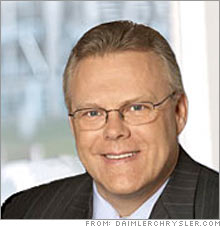LaSorda on the recordChrysler CEO Tom LaSorda has a lot of work to do after the carmaker lost $1.5 billion in the third quarter.DETROIT (Fortune) -- Chrysler CEO Tom LaSorda has gotten a much-needed vote of confidence from his boss, DaimlerChrysler (Charts) chairman Dieter Zetsche. But LaSorda has a lot of work to do after Chrysler lost $1.5 billion in the third quarter because of overproduction and slumping light truck sales, and it's in the midst of a vast cost-cutting scheme. In an interview at the Detroit Auto Show with Fortune's Alex Taylor III, LaSorda talked about Chrysler's excess inventory problems, a deal to produce small cars in China, and the difficulties of competing with Toyota (Charts).
Last year, you produced so many vehicles that the market couldn't absorb that you built some without dealer orders and stacked them up in outdoor parking lots all over Detroit. What have you learned from that experience? Obviously, I take full responsibility for it. I acted too slow. We really should have done something with our inventory a year ago, even before I took over as CEO, but we'll leave that aside. I took 100,000 units out of production after I took over in the first part of 2006, but it obviously wasn't enough. My sales plan didn't work in the third quarter. Then I had the relationship issue with the dealers - I really hurt that because of all this. And we've got to win them back. They've got to make money - that's my focus. That's why I took over sales and marketing - I had to make some moves there. And I'm not asking for sympathy from the dealers. I'm saying I messed up. I was responsible for it and I want a chance to earn their respect back. So even though we ended the year with 538,000 units in inventory, we've got to continue to draw that down over time. So it is going to be tough for the next 30-60 days. We need to stimulate sales, marketing and branding towards the product again. And make sure everything we do from the brand side is aligned with what the dealers do. I told the advertising guys, it is real simple. You better build my brand equity and bring people to the showroom. I don't care if you ever win an award. The award for me is the dealers are happy, the consumers are buying my cars, they're profitable and I'm profitable. That's all I want. You are reportedly trying to cut your costs by $1 billion. How's that coming? We're pretty much looking by the end of February to outline the whole plan. It's got to look at all facets of the business, from revenue to international growth to the typical cost items like right-sizing capacity. I see it pretty wide-spread. What do you figure your cost disadvantage is vis a vis Toyota? From a legacy perspective, hourly wages including benefits, we pay about $25 per hour more than Toyota. Then we look at estimates for cost structure and where their margins might be. I figure our cost disadvantage is upwards of three thousand dollars per unit When you've got the products, you can go after them. If you look at the Jeep Wrangler, for example, we can't make enough of them. Some of the other segments get a little tougher. You are close to a deal with Chery, a Chinese automaker, to make subcompact B class cars for sale in the U.S. Why are you doing that? If we get into the small car segment, we have to look at a low-cost production base to do it. Nobody produces B cars in this country. Overall, we see the B-segment as not a big play in the U.S. yet - the market is 230,000-250,000 units. But as a percentage of volume in Canada, Mexico, South America it is very big. And of course in Western Europe, if you look at A, B, and C segments combined, it is almost 50 percent. There are two segments we are not in - A and B. We're just not even a player in certain areas of the world because we are not there. I'm the only player among the world's top ten producers who isn't in the segment. We looked at Asia and Europe for production. Some of those partners fell out pretty quick. To arrive at our costs, we looked at what the market was from a pricing perspective. Then we backed out dealer margins. We aren't going to lose money at this. We have to make a profit margin after any incentives or discounting. What we did was take a typically equipped vehicle and find partners who can play in this space. And it had to have the features consumers wanted in radio systems, safety and so on. We had all that quantified. We looked at other parts of Asia and these ones in China came out the best. Chery can build an assembly plant in 14 to 18 months. A plant over there with 250,000 units of capacity is roughly $250 million to $300 million. Here it is somewhere from $750 million on up. Zetsche gave you a vote of confidence that must feel pretty good. What's the future of the DaimlerChrysler relationship? Dieter Zetsche ran this division and people keep forgetting that. I've been with him for the entire six years of the Daimler-Chrysler merger. I've grown with him and been one of his top lieutenants. I think the relationship is solid. _______________ More news from Detroit:
|
|

